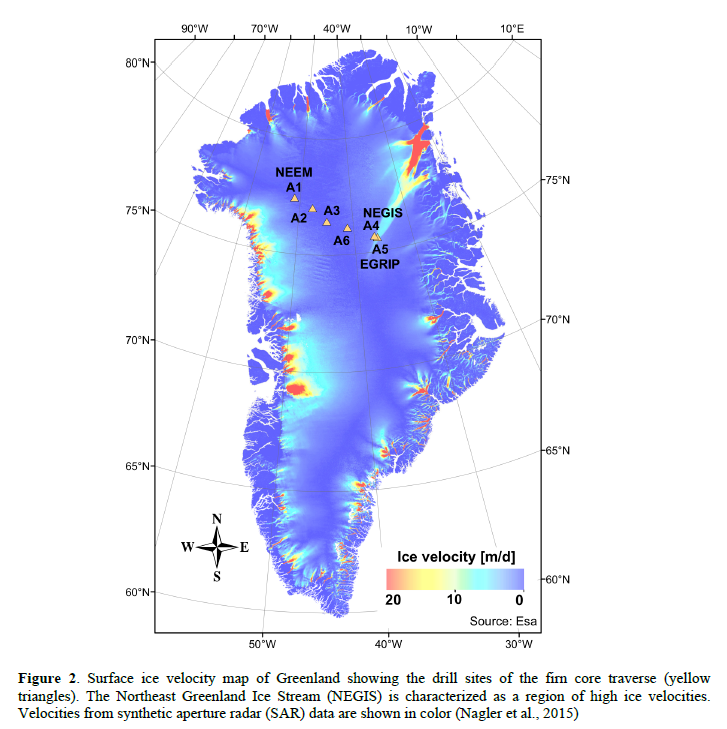Msc Sam Black will defend his thesis investigating the chemistry in the Greenland shallow traverse cores obtained in 2015. Further Msc Patrick Stephan Zens defended his thesis in Uppsala in end of May, and has agreed to update us on his findings following the defense of Sam. You are all most welcome to join.
Below the two abstracts
Analysis of chemistry in 6 shallow cores from Northern Greenland
by Sam Black
This report examines a series of 6 short firn cores collected from the Greenland Ice Sheet in May 2015. The cores were collected by hand using a IDDO drill during the traverse from NEEM to NGRIP and analysed at the Centre for Ice and Climate using the institutions continuous flow analysis system. More specifically, this report aims to present a number of different ice core proxies measured from the cores, their similarities, differences and causes.
Aerosol Input and Snow Accumulation Rates on the Northern Greenland Ice Sheet –Reconstructed by means of Continuous Flow Analysis (CFA) of 6 shallow firn cores
by Patrick Stephan Zens
Ice, firn and snow cores from the Greenland ice sheet offer a unique opportunity to reconstruct past climate conditions. These can be analyzed with continuous flow analysis (CFA) in order to acquire proxy information about ancient atmospheric aerosol concentrations, snow accumulation rates or temperature variations, atmospheric composition, solar activity as well as volcanism and biological activity.
This project deals with high-resolution CFA applied on six shallow firn cores (A1-A6) from Northern Greenland taken during a 456 km long traverse from the deep ice core drilling sites NEEM to that called EGRIP. The practical part included CFA measurements by means of fluorescence spectroscopy for obtaining NH4 +, Ca2+ and H2O2, absorption spectroscopy for H+, an ion selective electrode (ISE) for Na+ as well as insoluble dust and water electrolytic conductivity measurements.
The analytical part consisted of calibrations of the measurements, the reconstruction of the depth scale of the snow/firn cores and defining annual layers using H2O2. Field density measurements and the annual layer thicknesses were used to identify annual mean snow accumulation rates.
These high-resolution firn records allowed determining accurate monthly maximum and minimum aerosol concentrations in order to evaluate seasonal deposition patterns and validate the applied dating method. The reconstructed ages ranged from 17 ± 1 to 54 ± 2 years along a northwest-southeast gradient. Statistical tests resulted merely for H2O2 in correlations between the three western cores, probably explained by the dating method, which forces the annual summer maxima and winter minima of H2O2 to correlate. Trend analysis resulted in no significant changes over time except for the conductivity measurements of the two longest/oldest firn cores. This is associated with decreasing acidifying anthropogenic sulfur emissions since the 1970’s.
Annual mean snow accumulation rates ranged from 0.235 ± 0.061 m w.eq.a-1 in the very west of the traverse to 0.103 ± 0.036 m w.eq.a-1 centered on the Greenland ice-divide. Correlation maps derived from ERA-Interim reanalysis were used, to indicate potential correlations between the six firn cores. Similar to the results for H2O2, a significant correlation could only be determined between the three westernmost cores. A significant increasing trend of snow accumulation since the 1960’s was
detectable for core A6 in the ice sheet’s interior.
These traverse cores represent point measurements in a large, highly variable and poorly studied region of Northern Greenland. Hence, more extensive investigations are essential to reduce the uncertainty, cancel out influencing snow surface processes and improve the representativeness of isolated locations. Conclusively, the produced results update impurity and accumulation datasets until 2015, determine trends and provide input for surface mass balance estimations and ground truth data
for satellite observations.
Keywords: Continuous flow analysis, Greenland, Shallow firn core, Aerosol, Snow accumulation,
Glaciochemistry
